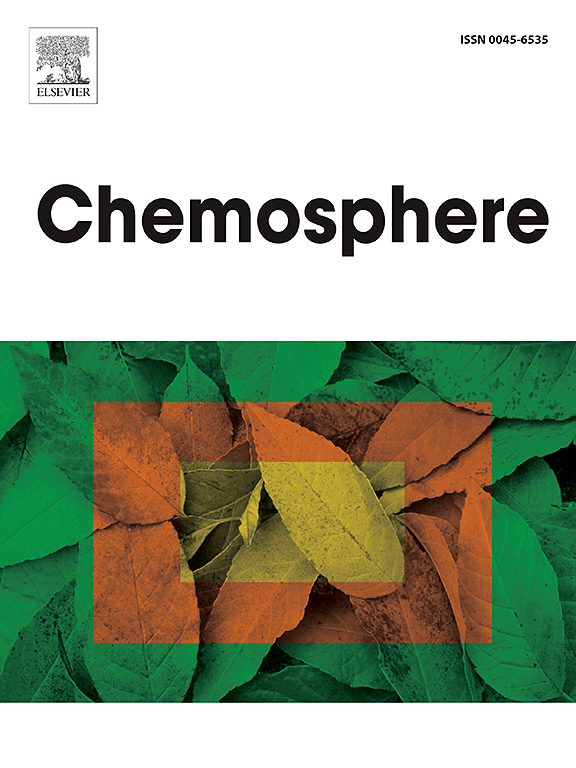流动测量揭示的长三角地区环挥发性甲基硅氧烷大气新发污染物
IF 8.1
2区 环境科学与生态学
Q1 ENVIRONMENTAL SCIENCES
引用次数: 0
摘要
环挥发性甲基硅氧烷(cVMS)是一类大批量生产的化学品,由于其对空气质量和人体健康的潜在不利影响而受到越来越多的关注。在cVMS中,八甲基环四硅氧烷(D4)和十甲基环五硅氧烷(D5)在全球产量占主导地位,中国在其生产和消费中发挥着关键作用。尽管这些化合物被广泛使用,但在中国,甚至在中国人口最密集、经济最发达的长江三角洲地区,大气中这些化合物的含量和来源在很大程度上仍然未知。在这里,我们首次采用高灵敏度的Vocus质子转移反应飞行时间质谱仪(PTR-ToF-MS)对长三角地区的大气D4和D5进行了移动测量。D5的平均浓度(21.4±20.5 pptv)与发达国家的水平相当,而长三角洲地区的D4浓度(50.1±41.8 pptv)比这些发达国家城市地区通常报告的D4水平高出约一个数量级。D4/D5比值(平均值1.3)显著高于全球平均值(平均值1.0),表明工业排放是该地区D4浓度的主要驱动因素。在工业设施附近观察到D4水平升高(高达1119.4 pptv),加强了它们作为主要局部污染源的作用。然而,D5的空间分布受人口密度和经济发展水平(人均收入)的影响。这些发现为快速发展地区大气cVMS的空间分布和社会经济驱动因素提供了新的见解,与以往主要关注发达经济体的研究形成了有价值的对比。本文章由计算机程序翻译,如有差异,请以英文原文为准。

Atmospheric emerging pollutants of cyclic volatile methyl siloxanes across the Yangtze River Delta region revealed by mobile measurements
Cyclic volatile methyl siloxanes (cVMS) are a large class of high-production-volume chemicals that have garnered increasing scrutiny due to their potential adverse effects on air quality and human health. Among cVMS, octamethylcyclotetrasiloxane (D4) and decamethylcyclopentasiloxane (D5) dominate global production, with China playing a pivotal role in their manufacture and consumption. Despite their widespread use, the atmospheric occurrence and sources of these compounds in China, even in the Yangtze River Delta (YRD)-the nation's most densely populated and economically developed region-remain largely unknown. Here, we present the first mobile measurements of atmospheric D4 and D5 across the YRD, employing a highly sensitive Vocus Proton Transfer Reaction Time-of-Flight Mass Spectrometer (PTR-ToF-MS). The average concentration of D5 (21.4 ± 20.5 pptv) was comparable to levels found in developed countries, while D4 concentrations (50.1 ± 41.8 pptv) in the YRD were approximately an order of magnitude higher than D4 levels typically reported for urban areas in those same developed countries. The D4/D5 ratio (mean 1.3) was significantly higher than the global average (<1.0), indicating that industrial emissions are a major driver of D4 concentrations in the region. Elevated D4 levels (up to 1119.4 pptv) were observed near industrial facilities, reinforcing their role as prominent localized sources. The spatial distribution of D5, however, was influenced by both population density and the level of economic development (per capita income). These findings offer new insights into the spatial distribution and socioeconomic drivers of atmospheric cVMS in rapidly developing regions, providing a valuable contrast to previous studies primarily focused on developed economies.
求助全文
通过发布文献求助,成功后即可免费获取论文全文。
去求助
来源期刊

Chemosphere
环境科学-环境科学
CiteScore
15.80
自引率
8.00%
发文量
4975
审稿时长
3.4 months
期刊介绍:
Chemosphere, being an international multidisciplinary journal, is dedicated to publishing original communications and review articles on chemicals in the environment. The scope covers a wide range of topics, including the identification, quantification, behavior, fate, toxicology, treatment, and remediation of chemicals in the bio-, hydro-, litho-, and atmosphere, ensuring the broad dissemination of research in this field.
 求助内容:
求助内容: 应助结果提醒方式:
应助结果提醒方式:


